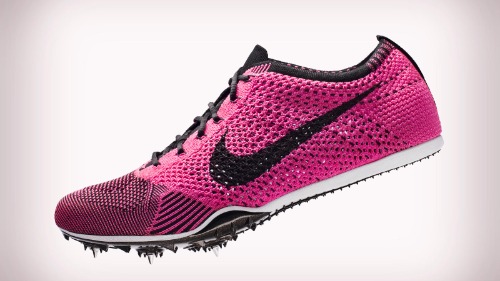Recently, my stomach has been churning about all the negatives I hear about how brands leave track & field. First of all, no one builds a $281 million sanctuary to the sport called the renovated Hayward Field and then, stops supporting the sport.
So, I made a coffee, took a walk, listened to some Graham Parker (Discovering Japan, Want You Back) and Jim Carroll (Wicked Gravity, Crow, Catholic Boy) and this is what transpired.

Nike spikes, special make for Matthew Centrowitz, Rio 2016 Olympic gold medalist, 1,500m, photo courtesy of Nike.com
For about the past decade, just before the Pre Classic, or perhaps a USATF championship, a business writer from an Oregon newspaper writes virtually the same story each year; that Nike is getting out of running, dumping all sponsorships, and that the $50 billion company is going to blow up, due to its own pretentiousness.
Nothing could be farther from the truth.
Although many are disturbed about how many athletes, not only in athletics, but in European football, have been taken off the Nike sponsorship food trough, most do not know how many new athletes, especially women athletes that Nike athletics has picked up this year.
Nike recently signed Mt.SAC Relays, just a week away and the money that they put into the Arcadia Invitational, most likely the finest high school meet in the universe, just shows that they have reprioritized their goals.
My frustration is that Nike employees can not speak on the record at all anymore, like most brands. All are afraid of saying something rash that might challenge their stock valuation or that some slapdick investor will data mine their quote and use it in a suit to say so and so devalued their 100,000 shares of stock. This stuff happens, so brands have to be careful.
How do I get my info? Just like I always have. Research. If one looks at social media, newspaper articles, press releases, one learns about obvious changes at Nike.
The word, a year or so ago was that when long time sports marketing professionals left Nike, all hell would break loose. Issue is this, two years of a pandemic, challenges in the supply chain, affecting the entire industry, and paradigm shifts in how Nike sells product, and a questioning, as the Swoosh always does, on how they value sports marketing, has changed the perception of how the brand sponsors track & field athletes.
Yes, Nike has a long term deal with USATF. Frustration with how USATF spends their money is not Nike’s fault. Some of it is just that USATF does not say much, and it drives people crazy. The lack of support of important meets, the lack of promotions of non USATF championships, and the charging of fans to see USATF.TV are just a few of the things that irritate me.
But, I do not run USATF. And I do not run Nike.
I am trying to understand how Nike, after having literally survived early on, due to the support of specialty retailers, is moving away from brick and mortars, seeing that they can sell their products directly at higher margins. Does it matter that this could kill many running stores? Running is such a small part of the business now, I am not sure it matters. Savvy brands like adidas, Brooks, and ON running get it, and are thriving, going into the grassroots areas that Nike has abandoned.
During the past couple years, adidas and PUMA, among others have made savvy additions to their global sports portfolios in the quiet of the pandemic. Their styles differ greatly, from the big American mega brand, Nike. But understand, Nike learned it all from the father of sports marketing, the late Horst Dassler, who shook up adidas for a short time in the 1980s, and whose lieutenants have worked for nearly every global brand and every successful Olympic campaign since 1984. Dassler was the nephew of the founder, and he worked incessantly, building relationships with federations, sports, and building the brand adidas into the global super brand it is today.
Nike took what they learned from Dassler, and churned out a revolutionary approach, sometimes well received, sometimes not. Nike reinvented sports marketing.
The difference was, under Phil Knight, Nike sports marketing changed the paradigm. The names such as Tom Sturak and Geoff Hollister should never be forgotten. They believed in the sport until their last breaths.
That is not to say that Nike does not support grassroots running. Their long-term commitment to the Nike Outdoor and Nike Indoor means that there are two indoor and outdoor high school championships, one by New Balance, which went on its own, and one by Nike, who supported the actual founders of indoor and outdoor champs, NSAF. This annoys me, as the same kids get feted, but not my issue.
The truth is this, 80 percent of track & field sports marketing is done by Nike and adidas. Next is PUMA, New Balance, Brooks, and ASICS, and coming up quickly, On running. At each of these brands, there are people who absolutely love the sport of track & field. Without these voices in the corporate desert, no sponsorship would exist.
Without their support, without some brand exec getting on the top of a table and screaming (this did happen), things do not get done. So, keep buying running shoes (the ones that work for you), at five per year (average high school track athlete buys 5-6 pairs of running shoes a year, at $150 average cost a pair), and keep the brands happy.
Almost all running brands are at record sales. The key is this: The brands that support grass roots do well. When they take their eye off the ball, not building track spikes, not making team uniforms in five colors (and same styles), and dropping meets, they loose support.
Funny how I have to write this column every five years or so. It is, as if brands forget how they got to the top.
It is a simple word, but not a simple business. And the word is, hold on, “Running”.





















